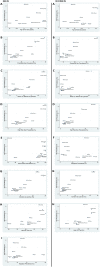HIV Prevalence Correlates with High-Risk Sexual Behavior in Ethiopia's Regions
- PMID: 26496073
- PMCID: PMC4619767
- DOI: 10.1371/journal.pone.0140835
HIV Prevalence Correlates with High-Risk Sexual Behavior in Ethiopia's Regions
Abstract
Background: HIV prevalence varies between 0.9 and 6.5% in Ethiopia's eleven regions. Little has been published examining the reasons for this variation.
Methods: We evaluated the relationship between HIV prevalence by region and a range of risk factors in the 2005 and 2011 Ethiopian Demographic Health Surveys. Pearson's correlation was used to assess the relationship between HIV prevalence and each variable.
Results: There was a strong association between HIV prevalence and three markers of sexual risk: mean lifetime number of partners (men: r = 0.87; P < 0.001; women: r = 0.60; P = 0.05); reporting sex with a non-married, non-cohabiting partner (men: r = 0.92; P < 0.001, women r = 0.93; P < 0.001); and premarital sex. Condom usage and HIV testing were positively associated with HIV prevalence, while the prevalence of circumcision, polygamy, age at sexual debut and male migration were not associated with HIV prevalence.
Conclusion: Variation in sexual behavior may contribute to the large variations in HIV prevalence by region in Ethiopia. Population-level interventions to reduce risky sexual behavior in high HIV incidence regions should be considered.
Conflict of interest statement
Figures



Similar articles
-
HIV prevalence by race co-varies closely with concurrency and number of sex partners in South Africa.PLoS One. 2013 May 21;8(5):e64080. doi: 10.1371/journal.pone.0064080. Print 2013. PLoS One. 2013. PMID: 23704973 Free PMC article.
-
HIV prevalence correlated with circumcision prevalence and high-risk sexual behavior in India's states: an ecological study.F1000Res. 2019 Jan 15;8:60. doi: 10.12688/f1000research.17807.2. eCollection 2019. F1000Res. 2019. PMID: 31316754 Free PMC article.
-
Voluntary medical male circumcision and sexual practices among sexually active circumcised men in Mzuzu, Malawi: a cross-sectional study.BMC Public Health. 2020 Feb 11;20(1):211. doi: 10.1186/s12889-020-8309-5. BMC Public Health. 2020. PMID: 32046686 Free PMC article.
-
Changes in sexual behaviour and practice and HIV prevalence indicators among young people aged 15-24 years in Zambia: an in-depth analysis of the 2001-2002 and 2007 Zambia Demographic and Health Surveys.SAHARA J. 2013;10(3-4):150-62. doi: 10.1080/17290376.2014.903620. Epub 2014 Apr 7. SAHARA J. 2013. PMID: 24702245 Free PMC article. Review.
-
Association between medical male circumcision and HIV risk compensation among heterosexual men: a systematic review and meta-analysis.Lancet Glob Health. 2021 Jul;9(7):e932-e941. doi: 10.1016/S2214-109X(21)00102-9. Epub 2021 Apr 30. Lancet Glob Health. 2021. PMID: 33939956 Free PMC article.
Cited by
-
Molecular and Immunological Diagnostic Techniques of Medical Viruses.Int J Microbiol. 2020 Sep 4;2020:8832728. doi: 10.1155/2020/8832728. eCollection 2020. Int J Microbiol. 2020. PMID: 32908530 Free PMC article. Review.
-
Strong association between higher-risk sex and HIV prevalence at the regional level: an ecological study of 27 sub-Saharan African countries.F1000Res. 2018 Dec 2;7:1879. doi: 10.12688/f1000research.17108.1. eCollection 2018. F1000Res. 2018. PMID: 30800288 Free PMC article.
-
HIV prevalence by ethnic group covaries with prevalence of herpes simplex virus-2 and high-risk sex in Uganda: An ecological study.PLoS One. 2018 Apr 4;13(4):e0195431. doi: 10.1371/journal.pone.0195431. eCollection 2018. PLoS One. 2018. PMID: 29617423 Free PMC article.
-
Prevalence of HIV/AIDS Infection among Sexually Active Women in Ethiopia: Further Analysis of 2016 EDHS.AIDS Res Treat. 2022 Nov 7;2022:8971654. doi: 10.1155/2022/8971654. eCollection 2022. AIDS Res Treat. 2022. PMID: 36389644 Free PMC article.
-
Prevalence of human papillomaviruses in self-collected samples among women attending antenatal care in Ethiopia: a cross-sectional study.Ecancermedicalscience. 2024 Aug 14;18:1739. doi: 10.3332/ecancer.2024.1739. eCollection 2024. Ecancermedicalscience. 2024. PMID: 39421164 Free PMC article.
References
-
- Auvert B, Buve A, Ferry B, Carael M, Morison L, Lagarde E, et al. (2001) Ecological and individual level analysis of risk factors for HIV infection in four urban populations in sub-Saharan Africa with different levels of HIV infection. AIDS 15 Suppl 4: S15–30. - PubMed
-
- Mishra V, Medley A, Hong R, Gu Y, Robey B (2009) Levels and spread of HIV seroprevalence and associated factors: evidence from national household surveys. Levels and spread of HIV seroprevalence and associated factors: evidence from national household surveys.
-
- Aral SO, Holmes KK, Padian NS, Cates W Jr. (1996) Overview: individual and population approaches to the epidemiology and prevention of sexually transmitted diseases and human immunodeficiency virus infection. J Infect Dis 174 Suppl 2: S127–133. - PubMed
MeSH terms
LinkOut - more resources
Full Text Sources
Other Literature Sources
Medical

